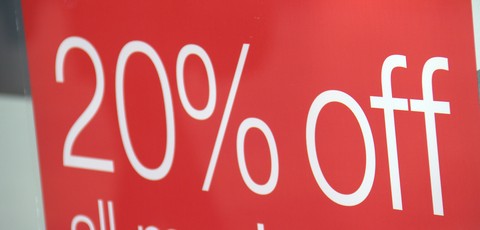If your sales figures are down, and you want a quick-fix solution, offering your customers a discount may seem your only option. However, this may not be the best solution. Here we look at why discounting may be an ill-advised move.

We spoke to Shweta Jhajharia of The London Coaching Group who explains that business owners should focus more on providing value than discounts when sales dry up. Many businesses are also unaware of how discounts affect the bottom-line and they can eat up profit margins if you get the numbers wrong.
The real impact of discounting on profitability
If you are providing customers with a product or service for £100 which costs you £60 to provide, your profit in this example is £40.
Sales are slow, so you decide to reduce the cost to £90 – representing a 10% discount on the price.
So, your profit also falls – to £30, but the costs you incur in providing the product or service remain the same – £60.
Although the discount to the customer is relatively modest (10%), your profitability has fallen by 25%.
This example demonstrates the importance of looking at the real impact of discounting on the bottom line, not on prices.
Try increasing your prices
It may seem counter-intuitive, but if you have run a service industry for a while, you may actually consider raising your prices, rather than discounting them.
“If you have been in business for some years, your brand has gained value. You have proven that there is a market for your product and that in itself makes it more valuable.”
If your brand has built up a good reputation, you may be able to charge a premium for providing an established, worthy service. After all, you can provide a degree of assurance – something new entrants to the market cannot provide.
Of course, increasing your prices is not something you can do in isolation – there are many variables to consider before doing so – how much competition is there in the market, what type of service to your provide, what is your existing pricing structure, etc.
Unsurprisingly, the effect of increasing your prices is equally dramatic on profitability.
If you provide a service for £100, and your costs are £80, your profit is £20.
By increasing your price by 10% to £110, your profitability increases by 50%, to £30.
Alternatives to discounting
If you go to any supermarket, you’ll see hundreds of examples of clever pricing. They can offer better value for their customers, without the need to discount.
Some of the most common examples include two-for-one offers, buy one get one free, or discounts on future purchases.
Offers which involve a future purchase are particularly good for business, as they are eye-catching, but rely on the customer to use the offer at a future time.
“Analyse the numbers and you will realise the effect to your gross profit is not nearly as massive as giving a straight discount.”
You could consider offering something for free rather than providing a discount – work out the cost to your business of giving away smaller products, or including extra services which cost nothing for you to provide. You may well find that the impact on your bottom-line is lower than the effects of straight discounting.
If you feel you have no alternative to discounting, then make sure you still benefit in another way, such as receiving payment upfront in return for the discount, or shorter credit terms.
The bottom line
Shweta explains that, above all, you need to know the real effect price changes have on your business as a whole.
“Whenever you can, say no to discounting when trying to increase your sales, and instead think of smart pricing strategies to provide value without slashing your profits.”


Follow Company Bug